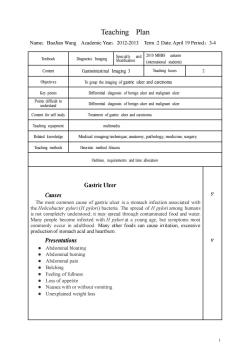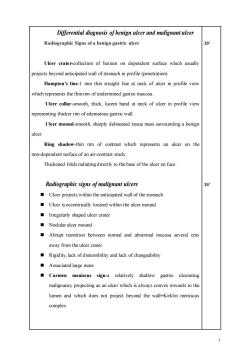山东第一医科大学(泰山医学院):《医学影像学》课程教学资源(授课教案)16.GI_tract-3

Teaching Plan Name:BaoJian Wang Academic Year:2012-2013 Term:2 Date.April 19 Period:3-4 Textbook Diagnostic Imaging nnd2010 MBS um atcmatonalstudents Content Gastrointestinal Imaging3 Teaching hours 2 Objectives To grasp the imaging of gastric uker and carcinoma Key points Differential diagnosis of benig uer and malignant uer po Differential diagnosis of benig uer and malignant uer Content for self study Treatment of gastric ulcer and carcinoma Teaching equipment multimedia Related knowedge Medical imaging technique,anatomy,pathology,medicine,surgery Teaching methods Heuristic method /discuss Outlines requirements and time allocation Gastric Ulcer Causes The most common cause of gastric ulcer is a stomach infection associated with the Helicobacter pylori (H pylori)bacteria.The spread of H pylori among humans is not completely understood:it may spread through contaminated food and water Many people become infected with H pyloriat a young age,but symptoms most commonly occur in adulthood.Many other foods can cause irritation,excessive production of stomach acid and heartburn. Presentations ●Abdominal pain ·Belching ●Feeling of fullness ·Loss of appetite .Nausea with or without vomiting .Unexplained weight loss
1 Teaching Plan Name:BaoJian Wang Academic Year:2012-2013 Term :2 Date.April 19 Period:3-4 Textbook Diagnostic Imaging Specialty and Stratification 2010 MBBS autumn (international students) Content Gastrointestinal Imaging 3 Teaching hours 2 Objectives To grasp the imaging of gastric ulcer and carcinoma Key points Differential diagnosis of benign ulcer and malignant ulcer Points difficult to understand Differential diagnosis of benign ulcer and malignant ulcer Content for self study Treatment of gastric ulcer and carcinoma Teaching equipment multimedia Related knowledge Medical imaging technique, anatomy, pathology, medicine, surgery Teaching methods Heuristic method /discuss Outlines, requirements and time allocation Gastric Ulcer Causes The most common cause of gastric ulcer is a stomach infection associated with the Helicobacter pylori (H pylori) bacteria. The spread of H pylori among humans is not completely understood; it may spread through contaminated food and water. Many people become infected with H pylori at a young age, but symptoms most commonly occur in adulthood. Many other foods can cause irritation, excessive production of stomach acid and heartburn. Presentations ⚫ Abdominal bloating ⚫ Abdominal burning ⚫ Abdominal pain ⚫ Belching ⚫ Feeling of fullness ⚫ Loss of appetite ⚫ Nausea with or without vomiting ⚫ Unexplained weight loss 5’ 5’

Outlinesrequrements and time Classification By Region/Location Duodenum(called duodenal ulcer) Esophagus (called esophageal ulcer) Stomach (called gastric ulcer) Meckel's diverticulum (called Meckels diverticulum ulcer,is very tender with palpation) dified Johnson Classification of peptic ulcers: a Type I:Ulcer along the body of the stomach,most often along the lesser curve at incisura angularis along the locus minoris resistantiae. Type II:Ulcer in the body in combination with duodenal ulcers AsOcatedwithacidoweecretion Type III:Inthe pyloric channel within 3 cm of pylorus.Associated with acid oversecretion Type IV:Proximal gastroesophageal ulcer Type V:Can occur throughout the stomach.Associated with chronic NSAID use(such as aspirin). Diagnostic Imaging 5 Single-contrast barium studies have an overall sensitivity of 75% Double-contrast barium examinations have a sensitivity of as high as 95%in the detection of gastric cancer. These results are comparable to those of endoscopy.and double-contrast barium examination remains a useful altemative to endoscopy. However,barium studies have a disadvantage in that biopsy specimens of the lesion cannot be obtained totest for Helicobacter pylori infection(an important factor in gastric ulcer development)or toevaluate for the presence of malignancy
2 Outlines, requirements and time allocation Classification By Region/Location • Duodenum (called duodenal ulcer) • Esophagus (called esophageal ulcer) • Stomach (called gastric ulcer) • Meckel's diverticulum (called Meckel's diverticulum ulcer; is very tender with palpation) Modified Johnson Classification of peptic ulcers: • Type I: Ulcer along the body of the stomach, most often along the lesser curve at incisura angularis along the locus minoris resistantiae. • Type II: Ulcer in the body in combination with duodenal ulcers. Associated with acid oversecretion. • Type III: In the pyloric channel within 3 cm of pylorus. Associated with acid oversecretion. • Type IV: Proximal gastroesophageal ulcer • Type V: Can occur throughout the stomach. Associated with chronic NSAID use (such as aspirin). • Diagnostic Imaging ⚫ Single-contrast barium studies have an overall sensitivity of 75% ⚫ Double-contrast barium examinations have a sensitivity of as high as 95% in the detection of gastric cancer. ⚫ These results are comparable to those of endoscopy, and double-contrast barium examination remains a useful alternative to endoscopy. ⚫ However, barium studies have a disadvantage in that biopsy specimens of the lesion cannot be obtained to test for Helicobacter pylori infection (an important factor in gastric ulcer development) or to evaluate for the presence of malignancy. 5’ 10’ 5’

Differential diagnosis of benign ulcer and malignant ulcer Radiographic Signs of a benign gastric ulcer Ulcer crater-collection of barium on dependent surface which usually projects beyond anticipated wall of stomach in profile(penetration) Hampton's line-1 mm thin straight line at neck of ulcer in profile view which represents the thin rim of undermined gastric mucosa. Ulcer collar-smooth,thick,lucent band at neck of ulcer in profile view representing thicker rim of edematous gastric wall. Uleer mound-smooth,sharply delineated tissue mass surrounding a benign ulcer. Ring shadow-thin rim of contrast which represents an ulcer on the on-dependent surface of an air-contrast study. Thickened folds radiatingdirectly to the base of the ulcer en face Radiographic signs of malignant ulcers Ulcer projects within the anticipated wall of the stomach Ulcer is eccentrically located within the ulcer mound Irregularly shaped ulcer crater ■Nodular ulcer mound Abrupt transition between normal and abnormal mucosa several cms away from the ulcer crater Rigidity,lack of distensibility and lack of changeability ■Associated large mass Carmen meniscus sign-a relatively shallow gastric ulcerating malignancy projecting as an ulcer which is always convex inwards to the lumen and which does not project beyond the wall=Kirklin meniscus complex 3
3 Differential diagnosis of benign ulcer and malignant ulcer Radiographic Signs of a benign gastric ulcer Ulcer crater-collection of barium on dependent surface which usually projects beyond anticipated wall of stomach in profile (penetration) Hampton’s line-1 mm thin straight line at neck of ulcer in profile view which represents the thin rim of undermined gastric mucosa. Ulcer collar-smooth, thick, lucent band at neck of ulcer in profile view representing thicker rim of edematous gastric wall. Ulcer mound-smooth, sharply delineated tissue mass surrounding a benign ulcer. Ring shadow-thin rim of contrast which represents an ulcer on the non-dependent surface of an air-contrast study. Thickened folds radiating directly to the base of the ulcer en face. Radiographic signs of malignant ulcers ◼ Ulcer projects within the anticipated wall of the stomach ◼ Ulcer is eccentrically located within the ulcer mound ◼ Irregularly shaped ulcer crater ◼ Nodular ulcer mound ◼ Abrupt transition between normal and abnormal mucosa several cms away from the ulcer crater ◼ Rigidity, lack of distensibility and lack of changeability ◼ Associated large mass ◼ Carmen meniscus sign-a relatively shallow gastric ulcerating malignancy projecting as an ulcer which is always convex inwards to the lumen and which does not project beyond the wall=Kirklin meniscus complex 20’ 20’

Carcinoma of Stomach Causes Helicobacter pylori infection ●Smoking Autoimmune atrophic gastritis,intestinal metaplasia,and genetic factors Morphology 分 Polypoid/fungating carcinoma Ulcerating/penetrating carcinoma (70%) Infiltrating/scirrhous type=linitis plastica Superficial spreading type-confined to mucosa/submucosa-NOT linitis plastic 10 Early Gastric Cancer Double-contrast barium upper GI examination is widely recognized as the radiologic technique of choice for diagnosing early gastric cancers. These lesions are confined to the mucosa or submucosa and are classified into 3 types Type I-Elevated lesions that protrude more than 5 mm into the lumen Type II-Superficial lesions that are elevated (IIa),flat(IIb),or depressed (IIc) Type III-Shallow,irregular ulcers surrounded by nodular,clubbed mucosal folds Advanced carcinoma o Polypoid carcinomas(an example of which appears below)are lobulated masses that protrude into the lumen.They may contain I or more areas of ulceration. With ulcerated carcinomas,an irregular crater is located in a rind of malignant tissue. ● Infiltrating carcinomas result in irregular narrowing of the stomach,with nodularity or spiculation of the mucosa. 4
4 Carcinoma of Stomach Causes ⚫ Helicobacter pylori infection ⚫ Smoking ⚫ Autoimmune atrophic gastritis, intestinal metaplasia, and genetic factors. Morphology ⚫ Polypoid/fungating carcinoma ⚫ Ulcerating/penetrating carcinoma (70%) ⚫ Infiltrating/scirrhous type=linitis plastica ⚫ Superficial spreading type-confined to mucosa/submucosa-NOT linitis plastic Early Gastric Cancer Double-contrast barium upper GI examination is widely recognized as the radiologic technique of choice for diagnosing early gastric cancers. These lesions are confined to the mucosa or submucosa and are classified into 3 types: Type I - Elevated lesions that protrude more than 5 mm into the lumen Type II - Superficial lesions that are elevated (IIa), flat (IIb), or depressed (IIc) Type III - Shallow, irregular ulcers surrounded by nodular, clubbed mucosal folds Advanced carcinoma ⚫ Polypoid carcinomas (an example of which appears below) are lobulated masses that protrude into the lumen. They may contain 1 or more areas of ulceration. ⚫ With ulcerated carcinomas, an irregular crater is located in a rind of malignant tissue. ⚫ Infiltrating carcinomas result in irregular narrowing of the stomach, with nodularity or spiculation of the mucosa. 5’ 5’ 10’ 10’
按次数下载不扣除下载券;
注册用户24小时内重复下载只扣除一次;
顺序:VIP每日次数-->可用次数-->下载券;
- 山东第一医科大学(泰山医学院):《医学影像学》课程教学资源(授课教案)15.GI_tract-2.doc
- 山东第一医科大学(泰山医学院):《医学影像学》课程教学资源(授课教案)14.GI_tract-1.doc
- 山东第一医科大学(泰山医学院):《医学影像学》课程教学资源(授课教案)13.Cardiac imaging.doc
- 山东第一医科大学(泰山医学院):《医学影像学》课程教学资源(授课教案)12.Pulmonary Tumors.doc
- 山东第一医科大学(泰山医学院):《医学影像学》课程教学资源(授课教案)11.Pulmonary inflammatory disease.doc
- 山东第一医科大学(泰山医学院):《医学影像学》课程教学资源(授课教案)10.Thoracic -Basic pathologic changes.doc
- 山东第一医科大学(泰山医学院):《医学影像学》课程教学资源(授课教案)9.Normal Chest X-ray.doc
- 山东第一医科大学(泰山医学院):《医学影像学》课程教学资源(授课教案)8.CNS4.doc
- 山东第一医科大学(泰山医学院):《医学影像学》课程教学资源(授课教案)7.CNS3.doc
- 山东第一医科大学(泰山医学院):《医学影像学》课程教学资源(授课教案)6.CNS2.doc
- 山东第一医科大学(泰山医学院):《医学影像学》课程教学资源(授课教案)5.CNS1.doc
- 山东第一医科大学(泰山医学院):《医学影像学》课程教学资源(授课教案)4.Foundations of Sonagraphy.doc
- 山东第一医科大学(泰山医学院):《医学影像学》课程教学资源(授课教案)3.Radioloy overview 3.doc
- 山东第一医科大学(泰山医学院):《医学影像学》课程教学资源(授课教案)2.Radiolgy overview 2.doc
- 山东第一医科大学(泰山医学院):《医学影像学》课程教学资源(授课教案)1.Radiology overview 1.doc
- 山东第一医科大学(泰山医学院):《医学影像学》课程教学大纲(英文版)Course syllabus-diagnostic imaging.doc
- 《妇产科学》课程教学资源(PPT课件讲稿)产后出血的诊断与处理.ppt
- 《妇产科学》课程教学资源(PPT课件讲稿)营养孕期(妊娠期营养).ppt
- 《妇产科学》课程教学资源(PPT课件讲稿)孕产妇用药.ppt
- 《妇产科学》课程教学资源(PPT课件讲稿)妊娠合并卵巢肿瘤诊疗进展.ppt
- 山东第一医科大学(泰山医学院):《医学影像学》课程教学资源(授课教案)17.GI_tract-4.doc
- 山东第一医科大学(泰山医学院):《医学影像学》课程教学资源(授课教案)18.Musculoskeletal Imaging1.doc
- 山东第一医科大学(泰山医学院):《医学影像学》课程教学资源(授课教案)19.Musculoskeletal Imaging2.doc
- 山东第一医科大学(泰山医学院):《医学影像学》课程教学资源(授课教案)20..Musculoskeletal Imaging3.doc
- 山东第一医科大学(泰山医学院):《医学影像学》课程教学资源(授课教案)21.Musculoskeletal Imaging4.doc
- 山东第一医科大学(泰山医学院):《医学影像学》课程教学资源(授课教案)22.Genitourinary 1.doc
- 山东第一医科大学(泰山医学院):《医学影像学》课程教学资源(授课教案)23.Genitourinary 2.doc
- 山东第一医科大学(泰山医学院):《医学影像学》课程教学资源(授课教案)24.Genitourinary 3.doc
- 山东第一医科大学(泰山医学院):《医学影像学》课程实验指导 Practical Guide to Diagnostic Imaging.doc
- 山东第一医科大学(泰山医学院):《医学影像学》课程教学资源(试卷习题)试卷一(试题).doc
- 山东第一医科大学(泰山医学院):《医学影像学》课程教学资源(试卷习题)试卷一(答案).doc
- 山东第一医科大学(泰山医学院):《医学影像学》课程教学资源(试卷习题)试卷二(试题).doc
- 山东第一医科大学(泰山医学院):《医学影像学》课程教学资源(试卷习题)试卷二(答案).doc
- 山东第一医科大学(泰山医学院):《医学影像学》课程教学资源(试卷习题)试卷三(答案).doc
- 山东第一医科大学(泰山医学院):《医学影像学》课程教学资源(试卷习题)试卷三(试题).doc
- 石河子大学:《健康评估》课程教学大纲(第一部分)健康评估与诊断 Health Assessment and Diagnosis.doc
- 石河子大学:《健康评估》课程教学授课教案(共九章).doc
- 石河子大学:《健康评估》课程教学资源(实验指导)健康评估实验指导手册.doc
- 《健康评估》课程教学资源(学习资料)健康评估护理诊断手册.doc
- 《健康评估》课程教学资源(试卷习题)健康评估练习及思考题(试题).doc
